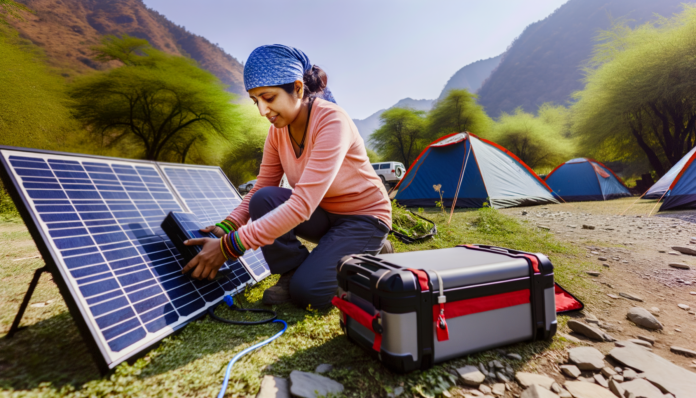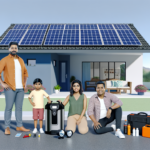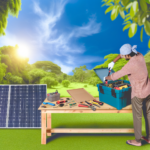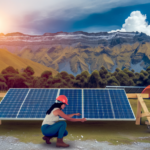Introduction
The Importance of Solar Gear Maintenance
As the world becomes increasingly aware of the need for sustainable practices, the use of solar gear has surged among eco-conscious travelers. Solar gear, such as portable solar panels, solar chargers, and solar-powered gadgets, offers a clean and renewable energy source that reduces reliance on fossil fuels. However, to ensure that these devices continue to function efficiently and have a long lifespan, proper maintenance is crucial. Regular upkeep not only maximizes the efficiency of your solar gear but also extends its operational life, ensuring that you get the most out of your investment while minimizing environmental impact.
Who This Guide is For
This guide is designed for eco-conscious travelers who rely on solar gear for their adventures. Whether you are a seasoned overlander, a weekend camper, or someone who enjoys off-grid hiking trips, maintaining your solar gear is essential for a seamless and sustainable experience. This guide will provide you with practical tips and techniques to keep your solar equipment in top condition, ensuring that you can continue to harness the power of the sun wherever your travels take you.
Overview of Solar Gear Longevity
Solar gear is known for its durability and low-maintenance requirements, but that doesn’t mean it can be neglected. The longevity of your solar equipment depends on several factors, including the quality of the components, the conditions in which they are used, and how well they are maintained. Proper care involves regular cleaning, inspection for damage, battery management, and appropriate storage. By following best practices for maintenance, you can significantly extend the life of your solar gear, ensuring that it remains a reliable source of renewable energy for years to come.
In this article, we will delve into the specifics of maintaining various types of solar gear, from portable solar panels to solar chargers and beyond. We will cover routine maintenance tips, advanced techniques, troubleshooting common problems, and strategies for maximizing efficiency and performance. By the end of this guide, you will have a comprehensive understanding of how to care for your solar gear, helping you to travel sustainably and efficiently.
Understanding Your Solar Gear
Types of Solar Gear
Solar gear encompasses a wide range of devices designed to harness the sun’s energy for various applications. Here are some common types:
- Solar Panels: These are the most recognizable form of solar gear, converting sunlight into electricity. They come in various forms, including rigid, flexible, and portable panels.
- Solar Chargers: Portable devices that can charge small electronics like smartphones, tablets, and cameras. They are ideal for travelers who need to keep their gadgets powered on the go.
- Solar Generators: These systems combine solar panels with battery storage and inverters to provide a reliable power source for larger applications, such as RVs, cabins, or emergency backup.
- Solar Lights: These include solar-powered lanterns, string lights, and pathway lights, which are perfect for illuminating campsites or outdoor spaces without relying on traditional power sources.
- Solar Water Heaters: These systems use solar energy to heat water, which can be used for showers, cooking, or cleaning while off-grid.
Key Components and Their Functions
Understanding the key components of your solar gear is crucial for effective maintenance and troubleshooting. Here are the primary components and their functions:
- Photovoltaic (PV) Cells: These are the heart of any solar panel, converting sunlight into direct current (DC) electricity.
- Inverter: This device converts the DC electricity generated by the PV cells into alternating current (AC), which is used by most household appliances and electronics.
- Charge Controller: This component regulates the voltage and current coming from the solar panels to the batteries, preventing overcharging and extending battery life.
- Batteries: These store the electricity generated by the solar panels for use when sunlight is not available, such as during the night or on cloudy days.
- Mounting Systems: These include brackets, racks, and poles used to secure solar panels in place, ensuring they are optimally positioned to capture sunlight.
- Cables and Connectors: These are essential for connecting the various components of the solar system, ensuring efficient and safe transmission of electricity.
Common Issues and How to Identify Them
Even with regular maintenance, solar gear can encounter issues. Here are some common problems and how to identify them:
- Low Power Output: If your solar panels are not generating as much electricity as expected, it could be due to dirt or debris on the panels, shading, or a malfunctioning component. Regularly clean your panels and check for obstructions or damage.
- Battery Not Charging: If your batteries are not holding a charge, it could be due to a faulty charge controller, damaged batteries, or poor connections. Inspect the charge controller and battery terminals for signs of wear or corrosion.
- Device Overheating: Overheating can occur if the inverter or other components are not adequately ventilated. Ensure that all components have proper airflow and are not exposed to direct sunlight for extended periods.
- Electrical Connections: Loose or corroded connections can lead to inefficiencies or system failures. Regularly inspect all cables and connectors, tightening and cleaning them as necessary.
- Firmware and Software Issues: Some advanced solar systems come with software that may need updates. Check the manufacturer’s guidelines for updating firmware and software to ensure optimal performance.
By understanding the types of solar gear, their key components, and common issues, you can better maintain your equipment and ensure it provides reliable power for your eco-conscious travels.
Routine Maintenance Tips
Cleaning Solar Panels and Devices
Maintaining the cleanliness of your solar panels is crucial for optimal performance. Dust, bird droppings, and other debris can obstruct sunlight, reducing the efficiency of your panels. Here are some tips for effective cleaning:
- Frequency: Clean your panels every six months, or more frequently if you live in a dusty area or experience frequent bird activity.
- Tools: Use a soft brush or a non-abrasive microfiber cloth to avoid scratching the surface. A hose with lukewarm water is usually sufficient for most cleaning tasks.
- Method: Avoid using hard tap water, as it can leave mineral residues. Instead, use clean, lukewarm water. For stubborn dirt, a gentle soap solution can be used, but ensure it is thoroughly rinsed off.
- Safety: Always turn off your solar power system before cleaning to avoid electrical hazards. If your panels are on a roof, use appropriate safety gear or consider hiring professionals.
Inspecting for Damage
Regular inspections can help you identify and address potential issues before they become serious problems. Here’s what to look for:
- Visual Inspection: Check for cracks, chips, or discoloration on the panels. These can indicate damage that may affect performance.
- Wiring: Inspect the wiring for signs of wear, corrosion, or damage from pests. Loose or frayed wires can lead to electrical failures.
- Mounting Hardware: Ensure that all mounting brackets and bolts are secure. High winds and other weather conditions can loosen these over time.
- Frequency: Conduct a thorough inspection every six months, or after severe weather events.
Battery Care and Management
Proper battery maintenance is essential for the longevity and efficiency of your solar power system. Here are some tips to keep your batteries in top condition:
- Regular Charging: Ensure that your batteries are regularly charged and not left in a discharged state for extended periods. This helps maintain their capacity and lifespan.
- Temperature Control: Batteries should be kept in a cool, dry place. Extreme temperatures can reduce their efficiency and lifespan.
- Inspection: Check for signs of corrosion or leakage. Clean any corrosion on terminals with a mixture of baking soda and water, and ensure connections are tight.
- Equalization: For lead-acid batteries, perform an equalization charge periodically to balance the cells and prevent sulfation.
Storing Your Solar Gear Properly
Proper storage of your solar gear when not in use can significantly extend its lifespan. Here are some best practices:
- Clean Before Storage: Ensure all components are clean and dry before storing them to prevent mold and corrosion.
- Storage Environment: Store your gear in a cool, dry place away from direct sunlight and extreme temperatures. A climate-controlled environment is ideal.
- Disassembly: If possible, disassemble your solar setup to reduce stress on the components. Store panels flat to avoid warping.
- Battery Storage: For long-term storage, charge batteries to about 50% and check them periodically. Lithium batteries should be stored at a partial charge, while lead-acid batteries should be fully charged.
By following these routine maintenance tips, you can ensure that your solar gear remains efficient and reliable, providing you with sustainable energy for years to come.
Advanced Maintenance Techniques
Testing Electrical Connections
Ensuring the integrity of your solar gear’s electrical connections is crucial for optimal performance. Over time, connections can become loose or corroded, leading to inefficiencies or even system failures. Here are some steps to test and maintain these connections:
- Visual Inspection: Regularly check for any visible signs of wear, corrosion, or damage on connectors, wires, and terminals. Look for discoloration, frayed wires, or loose connections.
- Use a Multimeter: A multimeter can help you measure voltage, current, and resistance. Ensure that the readings match the specifications provided by the manufacturer. Any significant deviations could indicate a problem.
- Tighten Connections: If you find any loose connections, tighten them carefully. Be cautious not to overtighten, as this can damage the components.
- Clean Corroded Parts: If you notice corrosion, clean the affected areas with a mixture of baking soda and water. Use a small brush to scrub gently, then rinse with clean water and dry thoroughly.
Firmware and Software Updates
Keeping your solar gear’s firmware and software up to date is essential for maintaining efficiency and security. Manufacturers often release updates to improve performance, fix bugs, and enhance features. Here’s how to manage these updates:
- Check for Updates Regularly: Visit the manufacturer’s website or use their mobile app to check for the latest firmware and software updates.
- Follow Manufacturer Instructions: Always follow the specific instructions provided by the manufacturer for updating firmware and software. This usually involves downloading the update to a USB drive or directly to the device via Wi-Fi.
- Backup Settings: Before performing any updates, back up your current settings. This ensures you can restore your system to its previous state if something goes wrong during the update process.
- Monitor Post-Update Performance: After updating, monitor your system to ensure it operates correctly. Check for any new features or settings that may need adjustment.
Replacing Worn-Out Components
Over time, certain components of your solar gear may wear out and require replacement to maintain optimal performance. Here are some tips for identifying and replacing these components:
- Identify Worn-Out Parts: Regularly inspect your solar panels, batteries, inverters, and other components for signs of wear and tear. Look for cracks, discoloration, or reduced performance.
- Consult the Manufacturer: Refer to the manufacturer’s guidelines to determine the expected lifespan of each component. This information can help you anticipate when replacements might be necessary.
- Purchase Genuine Parts: Always use genuine replacement parts from the manufacturer or authorized dealers. This ensures compatibility and maintains the integrity of your system.
- Follow Safety Protocols: When replacing components, follow all safety protocols. Disconnect the system from any power sources and wear appropriate protective gear.
- Professional Assistance: If you are unsure about replacing a component yourself, seek professional assistance. A qualified technician can ensure the replacement is done correctly and safely.
By implementing these advanced maintenance techniques, you can significantly extend the lifespan of your solar gear and ensure it operates at peak efficiency. Regular testing, timely updates, and proactive component replacement are key to maintaining a reliable and sustainable solar energy system.
Troubleshooting Common Problems
Low Power Output
Experiencing low power output from your solar gear can be frustrating, especially when you rely on it for your off-grid adventures. Here are some common causes and solutions:
- Dirty Panels: Dust, dirt, and debris can accumulate on your solar panels, blocking sunlight and reducing efficiency. Regularly clean your panels with a soft cloth and mild detergent to ensure they are free from obstructions.
- Shading: Even partial shading from trees, buildings, or other objects can significantly impact power output. Ensure your panels are placed in a location with maximum sun exposure throughout the day.
- Incorrect Angling: The angle at which your panels are positioned can affect their efficiency. Adjust the tilt of your panels to match the optimal angle for your location, typically equal to your latitude.
- Wiring Issues: Loose or corroded connections can lead to power loss. Inspect all electrical connections and ensure they are secure and free from corrosion.
Battery Not Charging
If your battery isn’t charging, it can disrupt your entire power system. Here are some steps to diagnose and fix the issue:
- Check Connections: Ensure all connections between the solar panels, charge controller, and battery are secure and free from corrosion. Loose or damaged wires can prevent proper charging.
- Inspect the Charge Controller: The charge controller regulates the flow of electricity from the panels to the battery. Check for any error codes or signs of malfunction. If necessary, reset or replace the charge controller.
- Battery Health: Over time, batteries can degrade and lose their ability to hold a charge. Test the battery with a multimeter to check its voltage. If the voltage is significantly lower than the rated capacity, it may be time to replace the battery.
- System Configuration: Ensure that your system components are compatible and correctly configured. Incorrect settings on the charge controller can prevent the battery from charging properly.
Device Overheating
Overheating can damage your solar gear and reduce its efficiency. Here are some tips to prevent and address overheating:
- Proper Ventilation: Ensure that your solar panels and other components are well-ventilated. Avoid placing them in enclosed spaces where heat can build up.
- Temperature Monitoring: Use temperature sensors or monitoring systems to keep an eye on the operating temperatures of your devices. If temperatures exceed safe limits, take action to cool them down.
- Shade and Insulation: In extremely hot conditions, consider providing shade for your panels or using reflective materials to reduce heat absorption. Insulating your battery and other sensitive components can also help maintain optimal temperatures.
- Cooling Systems: For high-power setups, consider investing in active cooling systems such as fans or heat sinks to dissipate excess heat.
By understanding and addressing these common issues, you can ensure that your solar gear remains reliable and efficient, allowing you to enjoy your eco-friendly adventures without interruption.
Maximizing Efficiency and Performance
Optimal Placement and Angling
Proper placement and angling of your solar panels are crucial for maximizing their efficiency. Solar panels should be positioned to capture the maximum amount of sunlight throughout the day. Here are some tips to ensure optimal placement and angling:
- Face the Right Direction: In the Northern Hemisphere, solar panels should face true south, while in the Southern Hemisphere, they should face true north. This orientation ensures that the panels receive the most sunlight throughout the day.
- Adjust the Tilt Angle: The tilt angle of your solar panels should be equal to the latitude of your location. This angle allows the panels to capture the maximum amount of sunlight. For example, if you are at a latitude of 30 degrees, your panels should be tilted at a 30-degree angle.
- Avoid Shading: Ensure that your solar panels are not shaded by trees, buildings, or other obstructions. Even partial shading can significantly reduce the efficiency of your solar panels.
- Use Adjustable Mounts: Consider using adjustable mounts that allow you to change the tilt angle of your panels seasonally. This adjustment can help you capture more sunlight during different times of the year.
Using Energy-Efficient Devices
Using energy-efficient devices can significantly reduce the overall energy consumption of your solar setup, allowing you to get the most out of your solar panels. Here are some strategies to consider:
- Opt for Energy Star Appliances: Energy Star-rated appliances are designed to be more energy-efficient than standard models. Using these appliances can help you reduce your energy consumption.
- LED Lighting: Replace traditional incandescent bulbs with LED lights. LEDs use significantly less energy and have a longer lifespan.
- Energy-Efficient Electronics: Choose laptops over desktop computers, as they generally consume less power. Additionally, unplug devices when they are not in use to prevent phantom loads.
- Smart Power Strips: Use smart power strips to automatically cut off power to devices that are not in use, further reducing energy consumption.
Monitoring and Tracking Performance
Regularly monitoring and tracking the performance of your solar system is essential for ensuring it operates at peak efficiency. Here are some methods to help you keep track of your system’s performance:
- Install a Solar Monitoring System: A solar monitoring system can provide real-time data on the performance of your solar panels, including energy production, consumption, and system health. This information can help you identify any issues and optimize your system’s performance.
- Use Mobile Apps: Many solar monitoring systems come with mobile apps that allow you to track your system’s performance from anywhere. These apps can send alerts if there are any issues with your system.
- Regular Inspections: Conduct regular inspections of your solar panels and other components to ensure they are in good condition. Look for signs of damage, dirt, or debris that could affect performance.
- Analyze Energy Usage: Keep track of your energy usage patterns and compare them with your solar energy production. This analysis can help you identify opportunities to reduce energy consumption and improve efficiency.
By following these tips for optimal placement and angling, using energy-efficient devices, and monitoring and tracking performance, you can maximize the efficiency and performance of your solar gear. This proactive approach will ensure that you get the most out of your investment and continue to enjoy the benefits of clean, renewable energy.
Conclusion
Recap of Key Points
As we conclude our guide on maintaining your solar gear, let’s revisit the essential points covered. Proper maintenance of solar gear is crucial for ensuring its longevity and optimal performance. We discussed the importance of understanding the different types of solar gear and their key components, as well as identifying common issues. Routine maintenance tips such as cleaning, inspecting for damage, battery care, and proper storage were highlighted. Advanced techniques like testing electrical connections, updating firmware, and replacing worn-out components were also covered. Additionally, we provided troubleshooting advice for common problems and tips for maximizing efficiency and performance.
Encouragement for Sustainable Practices
Embracing solar power and maintaining your solar gear is not just about enhancing your travel experience; it’s a commitment to sustainable living. By taking care of your solar equipment, you are ensuring that it continues to provide clean, renewable energy, reducing your reliance on fossil fuels and minimizing your carbon footprint. Every small step you take towards maintaining and using solar power contributes to a healthier planet. As an eco-conscious traveler, your efforts in preserving and optimizing your solar gear set an example for others and help promote a more sustainable future.
Additional Resources and Further Reading
For those looking to delve deeper into the world of solar power and sustainable travel, here are some valuable resources:
- Solar Power World – A comprehensive resource for the latest news and information on solar technology.
- Renogy Learning Center – Offers guides and tutorials on solar power systems, including RV solar kits and portable solar solutions.
- U.S. Department of Energy: Homeowner’s Guide to Going Solar – Provides insights into the benefits and considerations of adopting solar energy.
- Green Matters – A platform dedicated to environmental news and sustainable living tips.
- EcoWatch – Covers a wide range of topics related to sustainability, including renewable energy and eco-friendly travel.
By leveraging these resources, you can stay informed about the latest advancements in solar technology and continue to make informed decisions that support your eco-friendly lifestyle. Remember, maintaining your solar gear is a continuous process that pays off in the long run, both for you and the environment. Happy and sustainable travels!






